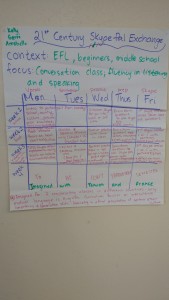Our group of four was tasked with reaching a collective understanding of the important characteristics and dimensions of projects in a language course, and applying this understanding to planning a project for an imagined educational context. This project plan was to be written on a piece of poster paper, specifying each step our imagined class would take towards the project’s completion. Our group was expected to present our project to the class, using our poster paper as a guide. My group distinguished itself from the other groups in two ways: (1) one of our members was a guest, a former MIIS alum and current director of a Los Angeles based English language program dedicated to helping international students transition to U.S.-based higher education, and (2) our group had nothing written on the paper when it came time to present the project. My goal here is to share the decisions my group made for the imagined educational context and project, and to describe the process by which these decisions were made. That our project never made it to the poster paper was somewhat embarrassing, but I am proud of the fact that our project and imagined context represented our shared interests and concerns regarding English language education.
Our imagined context was EFL at a university in a non-Native English (NNE) speaking country, specifically a grammar course made compulsory for students aspiring to be English language educators who met the minimum English proficiency requirements to gain entry into the university. This decision was not reached immediately. Our guest (whose contributions were greatly appreciated by me and the other group members) first asked us what contexts we expected ourselves to be teaching in upon (presumed) graduation from the M.A. TESOL program. This was an appropriate question to ask, because we would naturally be more motivated to create a project for a context in which we envision ourselves teaching. A fellow classmate and I both imagined ourselves teaching English language skills development courses at the community college level. A third classmate said that she would most likely teach grammar-focused courses in an EFL context abroad, a context in which she has previously worked and found to be challenging. I believe our group’s decision to teach in the EFL context was born of our empathy for this classmate’s experience and the challenges she anticipates returning to; the decision was also born of a shared understanding that teaching is full of challenges, and that we are better off facing challenges head on.
Like the imagined context, our group did not make decisions hastily for the project design. After much discussion, we decided the project would ask the students to create a newsletter (hardcopy or digital) for the university’s international cohort of native-English speakers (NES) who are also educators in training. This newsletter would inform the NES educators in training of the host country’s educational practices, past, present, and future. Because it is a grammar course, the newsletter would provide our learners with the opportunity to use the pattern-based grammar they would study throughout the semester. In order to make expectations clear, the teacher would provide the students with a checklist of the grammatical categories to be represented (e.g. verb tenses, passive and conditional constructions, etc.). The newsletter would be the product of all the students’ efforts (i.e. writing and editing articles, managing the placement/organization of the articles, overall design), and would thus foster peer-to-peer collaboration. It would also foster communication between the classroom and the greater campus community.
Our group’s decision to have the students collaboratively create a newsletter-type item was made relatively quickly. We liked that it was collaborative and multimodal. Before going any further, however, our guest asked if the document would serve any real communicative purpose, smartly implying that it should. Had our guest not asked this question, I believe we would have unwittingly committed the error of designing a writing based-project that removes writing, and by extension, language, from human to human (H2H) communication. Understanding that the newsletter would need a real audience in order to have a real communicative purpose, and that this audience would need to be English literate, we imagined the NNES students attending the university and sharing an interest in education.
I recall holding a red marker in my hand while the group discussed the above-mentioned topics. If I’m not mistaken, others in the group were holding markers in their hands, too, or at least had markers within reach. Despite this access to markers, we did not commit ourselves to writing on the poster paper, not as long as decisions needed to be made about how the imagined project would meet our imagined students’ needs. These decisions mattered to us because our imagined group of learners had become, through our discussion, very real. Another, less romantic but no less real, reason why we did not use the markers was because we did not stick to our assigned roles (i.e. leader, scribe, announcer, “chaser”). Even though we failed to write on the poster paper, I would be happy to work with these individuals again, because they were effective H2H communicators, keen to communicate their own opinions and ideas, and keen to listen to the contributions of others. I do wonder, though, how we’d each respond to our imagined students hosting similar H2H discussions, and managing to not produce the newsletter.



